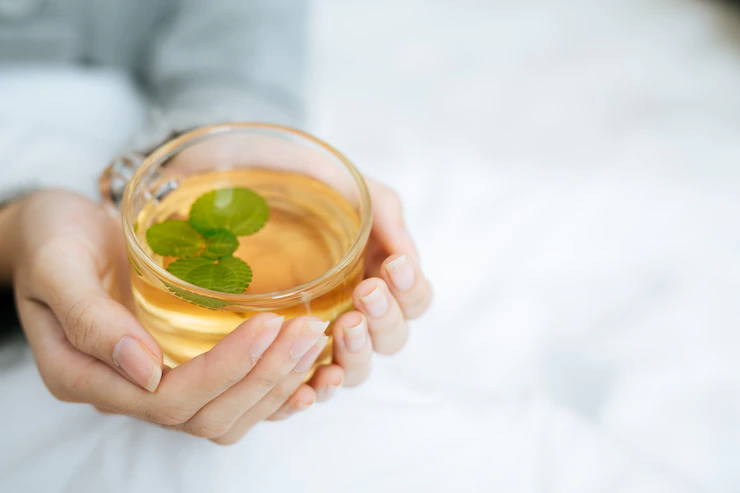Legend has it that tea was first discovered in 2737 B.C. when the Chinese Emperor, Shen Nong, was boiling water and the leaves of a nearby tea plant blew into the water. The drink that emerged pleasantly surprised him and tea was born. This is, of course, is just a legend, what we do know is that tea was born in China some time before 1000 B.C.
According to Conundrum Tea, the new tea company, launched in September of 2015 by James Lissy “Traditional tea all has one thing in common; it all comes in four categories Black, Oolong, Green, and White, and from the same plant, Camellia Sinensis. Sometimes the plant will be grown differently depending on what type of tea the farmer is trying to make. However, the big difference between these teas comes in how the leaves are processed once they have been harvested. This is discussed in more detail below for the different types of teas.”

What should you know about tea?
Black Tea
The most processed type of tea and is fully oxidized; it also has the highest caffeine content, making it a great tea to enjoy in the morning. The color of the brewed tea is usually a very dark brown, red, or black and the taste can be very bold and strong, much like coffee. If a black tea is being made, after the leaves are plucked they are laid out on mats to wither. Withering dries the leaves so they don’t crumble throughout the rest of the tea making process. Next the leaves are rolled; this can either be done by hand or machine. This is where the leaves get their initial shape, the shape that the leafs are rolled into can greatly affect how the end product tastes. After rolling, black tea is allowed to oxidize or “ferment” as it is usually referred to. How long a tea is oxidized greatly changes how a tea tastes in the end. The oxidation process is why black teas have a very dark color and strong taste. Once the tea maker has determined that a tea has been oxidized enough, the leaves are immediately heated to stop the oxidation process and to finish drying the leaves.
You can try
Everest Sunrise Black Tea (Conundrum Tea ) – Origin: Jasbire in Ilam; Nepal Farm Name: Hariyali Cooperative Farmer: Purna Mukhiya ; Cultivation Method: All Natural
This double-roasted black tea has almost no astringency or dryness to it, but it contains some very complex, full flavors. It tastes of molasses, raisin, and sweet potato with more subtle hints of grape and caramelized the sugar. It has an incredibly sweet aftertaste for a black tea. The orange color of the brewed tea reminds us of a fire and the leaves have a strong, sweet fragrance along with a root vegetable smell, which is common for the high-altitude teas of Nepal.
Steeping and Storage
Use 2.5 grams (2 teaspoons) of loose leaf tea per 6 ounces of water. Steep with water ranging from 195 to 205 degrees for 3 to 5 minutes. Can be re-steeped up to 5 times.
Oolong Tea
Is in the middle as far as the amount of processing and it is partially oxidized. It doesn’t have as much caffeine as a black tea, but it has more than green tea. It typically takes on a yellow or amber color and the tastes range greatly from subtle to a bold taste that black teas have. After the tea leaves are plucked they are laid out to wither, just like black teas are. After this withering process the leaves are bruised, which is basically a continuation of the withering process but the leafs are continually moved around bamboo baskets and pressed by hand which “bruises” the leaves. The bruising starts the oxidation process; generally leaves are bruised and then laid out to oxidize several times. Next the leaves are pan fried for a short amount of time to stop the leaves from oxidizing, after these the leaves are immediately rolled and shaped. It is common for the leaves of an Oolong tea to be rolled into balls. Then the leaves are baked so the leaves keep their shape and to finish the drying process.
You should try
Jasmine Oolong Tea (Conundrum Tea) – Origin: Zhushan Township, in Nantou, Taiwan; Farm Name: Goe Tea Farmer: Alfredo Lin; Cultivation Method: All Natural
If you close your eyes while drinking this balled Oolong, you will feel as if you have been transported to the countryside of Taiwan with the floral and fruity flavors that this tea contains. It also has a smooth, buttery consistency to it. The brewed tea has a sun yellow color and floral aromas with hints of Jasmine that linger along with the taste!
Goe Tea is owned by Alfredo Lin and is in the Zhushan Township of Nantou, Taiwan, the farm is at an elevation of 980 feet (300 meters). Alfredo comes from a family full of tea farmers. He ventured out and started his own tea farm so he can do things his own way. In a country that is known for its chemical and pesticide use, Alfredo is one of the few who strays away from these chemicals as he is passionate about natural farming methods. He is currently working on becoming a tea master, which is a 30-year process, he is studying under the tea master Aones.
Steeping and Storage
Use 2.5 grams (1 teaspoon) of loose leaf tea per 6 ounces of water. Steep with water ranging from 185 to 205 degrees for 3 to 5 minutes. Can be re-steeped up to 6 times. Balled Oolong’s are best enjoyed over multiple short infusions, as the ball unfurls throughout the steeps, different flavors are released along with the leaves.
Green Tea
The most common type of tea in the western world, it is minimally processed and has a low amount of caffeine so it can be enjoyed throughout the majority of the day. As you would expect from the name, this tea has a green hue and it ranges in color from a very light to dark green. It usually has a “grassy” taste to it. After the leaves are plucked they are generally allowed to wither for a short amount of time then they are immediately steamed or roasted. Next the leaves are rolled into the desired shape and dried for the final product. Two common variations of green tea are Sencha and Gyokuro. Sencha is grown in full sunlight until the leaves are picked. Gyokuro is grown in full sunlight and is then shaded for an amount of time determined by the tea maker. This shade makes the plant grow at a slower pace and gives it the deep forest green color as well as the sweet taste that Gyokuro teas are known for.
You have to try
Emerald Gyokuro Green Tea Origin: Yabe Village in Yama, Japan; Farm Name: Kurihara Tea; Farmer: The Kurihara Family; Cultivation Method: All Natural
This coveted, award-winning Gyokuro green tea has deep, savory, unami flavors with a lasting sweet, lemongrass finish and it is not bitter at all. It is very rich and has the consistency of broth and full of health benefits.
The brewed tea has a light green and yellow color and it has an aroma of sweet grass. This Gyokuro was shaded beneath traditional bamboo shading for three weeks, which cuts out 85% of the sunlight. This is where the sweet taste comes from. Kurihara Tea is located in Yame, Japan and it is owned by the Kurihara family and their tea is grown at an altitude of 2,230 feet (680 meters). This family has been producing tea since the 1920’s and they have been in Yame since the 1940’s. They are known for their Gyokuro tea and they have won many awards for it including “Best Tea of Japan” at the North American Tea Conference in 2014. The strong flavors and fragrances of their tea are caused by the extreme temperature differences that are common in Yame.
Steeping and Storage
Use 2.5 grams (1 heaping teaspoon) of loose leaf tea per 6 ounces of water. Steep with water ranging from 150 to 175 degrees for 45 seconds to 1 minute. For subsequent steeps add 15 to 30 seconds. Can be re-steeped up to 4 times.
What else to try
White Tea
The least processed type of tea and it also has the lowest caffeine content. It is usually a very light color and a subtle taste. The buds and leaves for a white tea are simply laid out to wither and dry. Followed by inspection, testing, and packaging. You may be wondering, if this is the least labor intensive tea then why is it so expensive? While the processing of this tea is not very labor intensive the picking of this tea is. White tea can vary from being 100% young buds (leaves that are budding but have not yet opened up) to being a young bud with a few young leaves attached. This means that white tea has a very small window for harvesting, usually just a few days a year. On top of that the leaves and buds must be handled very carefully to keep the young leaves and buds intact. For the highest grades of white tea, you should be able to look at the bud and see very small silver hairs on it.
How to store your tea
Loose leaf tea should be stored in a cool, dark, and dry environment away from strong odors that the tea will most certainly absorb (do not store in the refrigerator or spice cabinet). It is best to store it in an airtight container, as this will reduce the amount of oxygen that interacts with the tea and thus preserving its life.
Keep in mind that these steeping instructions are merely a suggested starting point. Everyone has different tastes and preferences and you can adjust the amount of tea used and the steep time accordingly. If you would like your tea to have a stronger taste, add more tea leaves for better taste and enjoyment.
Conversely, if it is too strong, use fewer tea leaves. It is quite fun to play with the temperature of the water and the steep times to bring out different tastes and textures in the tea!
About company
Conundrum Tea is loose leaf tea company based in Longmont, Colorado. The founder and owner, James Lissy, started out as a tea enthusiast who got fed up with the tea industry and its lack of transparency. When you buy a tea from Conundrum Tea you know exactly which farm the tea came from and which cultivation methods were used. This means that each tea has its own unique story behind it and it is a story that we are proud to share with anyone who will listen! Conundrum Tea is not your average tea company, everything that they do and stand for sets us apart from other tea companies, they have the tea farmer’s best interest as well as the tea drinker’s best interest in mind.
Photo: Conundrum Tea



